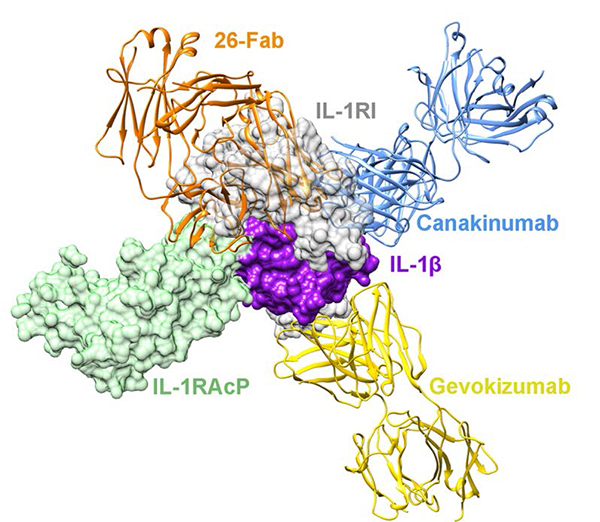
 中央研究院 生物化學研究所
中央研究院 生物化學研究所
Interleukin-1β (IL-1β) is a potent pleiotropic cytokine playing a central role in protecting cells from microbial pathogen infection or endogenous stress. After it binds to IL-1RI and recruits IL-1 receptor accessory protein (IL-1RAcP), signaling culminates in activation of NF-κB. Many pathophysiological diseases have been attributed to the derailment of IL-1β regulation. Several blocking reagents have been developed based on two mechanisms: blocking the binding of IL-1β to IL-1RI or inhibiting the recruitment of IL-1RAcP to the IL-1β initial complex. In order to simultaneously fulfill these two actions, a human anti-IL-1β neutralizing antibody IgG26 was screened from human genetic phage-display library and furthered structure-optimized to final version, IgG26AW. IgG26AW has a sub-nanomolar binding affinity for human IL-1β. We validated IgG26AW-neutralizing antibodies specific for IL-1β in vivo to prevent human IL-1β-driving IL-6 elevation in C56BL/6 mice. Mice underwent treatments with IgG26AW in A549 and MDA-MB-231 xenograft mouse cancer models have also been observed with tumor shrank and inhibition of tumor metastasis. The region where IgG26 binds to IL-1β also overlaps with the position where IL-1RI and IL-1RAcP bind, as revealed by the 26-Fab/IL-1β complex structure. Meanwhile, SPR experiments showed that IL-1β bound by IgG26AW prevented the further binding of IL-1RI and IL-1RAcP, which confirmed our inference from the result of protein structure. Therefore, the inhibitory mechanism of IgG26AW is to block the assembly of the IL-1β/IL-1RI/IL-1RAcP ternary complex which further inhibits downstream signaling. Based on its high affinity, high neutralizing potency, and novel binding epitope simultaneously occupying both IL-1RI and IL-1RAcP residues that bind to IL-1β, IgG26AW may be a new candidate for treatments of inflammation-related diseases or for complementary treatments of cancers in which the role of IL-1β is critical to pathogenesis.
